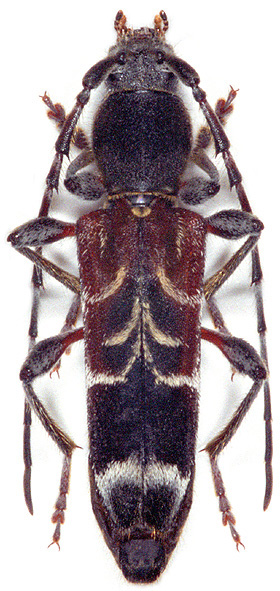Anaglyptus (Anaglyptus) ganglbaueri Reitter, 1886
Subfamilia:
CERAMBYCINAE / Tribus:
ANAGLYPTINI

[Photo © M.Hoskovec]
|
With the exception of about three species there is hardly any information regarding the biology of Anaglyptus. The larval substrate preferences of Anaglyptus ganglbaueri
are very similar to Paraclytus raddei (Ganglbauer, 1881) and larvae of both species can frequently be found together. The larval substrate is usually
found inside living hollow deciduous trees. It comprises a 1-5 cm thick layer of a dead and extremely tenacious red-brown wood in close contact to the sound and very compact heart wood.
Adults hatch in late autumn and overwinter in the pupal cells. The beetles emerge very early in the following spring. Anaglyptus ganglbaueri visits flowers and blossoming shrubs.
| Body length: | 9 - 15 mm |
| Life cycle: | 2 - 3 years |
| Adults in: | May - July |
| Host plant: | deciduous trees |
| Distribution: | Caucasus, Azerbaidjan, Turkey, Iran |
The depicted beetle was collected in Rudbar (North Iran).
Collected by M.Rejzek
|
Subfamilia: Cerambycinae Latreille, 1802
Tribus: Anaglyptini Lacordaire, 1869
Genus: Anaglyptus Mulsant, 1839
Subgenus: Anaglyptus Mulsant, 1839
Species: Anaglyptus (Anaglyptus) ganglbaueri Reitter, 1886

